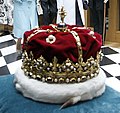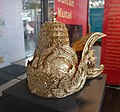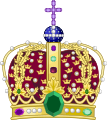Crown

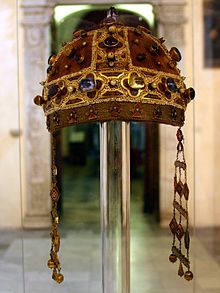

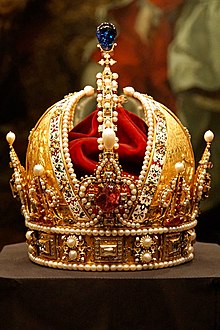
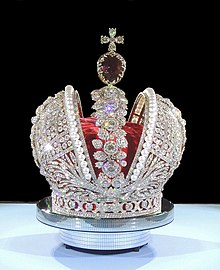


Acrownis a traditional form of head adornment, or hat, worn bymonarchsas a symbol of their power and dignity. A crown is often, by extension, a symbol of the monarch's government or items endorsed by it. The word itself is used, particularly in Commonwealth countries, as an abstract name for the monarchy itself (and, by extension, the state of which said monarch is head) as distinct from the individual who inhabits it (that is,The Crown). A specific type of crown (orcoronetfor lower ranks of peerage) is employed inheraldryunder strict rules. Indeed, some monarchies never had a physical crown, just a heraldic representation, as in the constitutional kingdom of Belgium.
Variations
[edit]- Costumeheadgear imitating a monarch's crown is also called a crown hat. Such costume crowns may be worn by actors portraying a monarch, people at costume parties, or ritual "monarchs" such as the king of aCarnivalkrewe,or the person who found the trinket in aking cake.
- Thenuptial crown,sometimes called acoronal,worn by a bride, and sometimes the bridegroom, at her wedding is found in many European cultures since ancient times. In the present day, it is most common inEastern Orthodoxcultures. The Eastern Orthodox marriage service has a section called the crowning, wherein the bride and groom are crowned as "king" and "queen" of their future household. In Greek weddings, the crowns arediademsusually made of white flowers, synthetic or real, often adorned withsilverormother of pearl.They are placed on the heads of the newlyweds and are held together by a ribbon of whitesilk.They are then kept by the couple as a reminder of their special day. In Slavic weddings, the crowns are usually made of ornate metal, designed to resemble an imperial crown, and are held above the newlyweds' heads by their best men. A parish usually owns one set to use for all the couples that are married there since these are much more expensive than Greek-style crowns. This was common in Catholic countries in the past.
- Crowns are also often used as symbols of religious status or veneration, by divinities (or their representation such as a statue) or by their representatives (e.g., theBlack Crownof the Karmapa Lama) sometimes used a model for wider use by devotees.
- According to theNew Testament,acrown of thornswas placed on the head ofJesusbefore hiscrucifixion;it has become a common symbol of martyrdom.
- According toRoman Catholictradition,theBlessed Virgin Marywas crowned asQueen of Heavenafter herassumptionintoheaven.She is often depicted wearing a crown, and statues of her in churches andshrinesareceremonially crownedduring May.
- TheCrown of Immortalityis also common in historical symbolism.
- The heraldic symbol ofThree Crowns,referring to the three evangelicalMagi (wise men),traditionally called kings, is believed thus to have become the symbol of the Swedish kingdom, but it also fits the historical (personal, dynastic)Kalmar Union(1397–1520) between the three kingdoms of Denmark, Sweden, and Norway.
- InIndia,crowns are known asmakuta(Sanskritfor "crest" ), and have been used in India since ancient times and are described adorning Hindu gods or kings. The makuta style was then copied by theIndianized kingdomsthat was influenced by Hindu-Buddhist concept of kingship in Southeast Asia, such as in Java and Bali in Indonesia, Cambodia, Burma and Thailand.
- In East Asia, there were crowns such as the Chinesemianguanand Japanesebenkanworn by emperors.
- Dancers of certain traditionalThai dancesoften wear crowns (mongkut) on their head. These are inspired in the crowns worn by deities andby kings.
- In pre-ColonialPhilippinescrown-likediadems,orputong,were worn byelite individualsanddeities,among an array of golden ornaments.[1][2]
- Theshamsawas a massive, jewel-inlaid ceremonial crown hung by a chain that was part of the regalia of theAbbasidandFatimidCaliphates.[3]
Terminology
[edit]Three distinct categories of crowns exist in thosemonarchiesthat use crowns or state regalia.
- Coronation
- Worn by monarchs when beingcrowned.
- State
- Worn by monarchs on other state occasions.
- Consort crowns
- Worn by aconsort,signifying rank granted as aconstitutionalcourtesyprotocol.
Crowns or similar headgear, as worn bynobilityand other high-ranking people below the ruler, are in English often calledcoronets;however, in many languages, this distinction is not made and the same word is used for both types of headgear (e.g., Frenchcouronne,GermanKrone,Dutchkroon). In some of these languages the term "rank crown" (rangkroon,etc.) refers to the way these crowns may be ranked according to hierarchical status. Inclassical antiquity,the crown (corona) that was sometimes awarded to people other than rulers, such as triumphalmilitarygeneralsorathletes,was actually awreathor chaplet, or ribbon-likediadem.
History
[edit]
Crowns have been discovered in pre-historic times fromHaryana,India.[4]The precursor to the crown was the browband called thediadem,which had been worn by theAchaemenid Persian emperors.It was adopted byConstantine Iand was worn by all subsequent rulers of the later Roman Empire. Almost all Sassanid kings wore crowns. One of the most famous kings who left numerous statues, reliefs, and coins of crowns is the kingShapur I.
Numerouscrowns of various formswere used in antiquity, such as theHedjet,Deshret,Pschent(double crown) andKhepreshofPharaonic Egypt.The Pharaohs of Egypt also wore the diadem, which was associated with solar cults, an association which was not completely lost, as it was later revived under the Roman Emperor Augustus.[5]By the time of the Pharaoh Amenophis III (r.1390–1352c) wearing a diadem clearly became a symbol of royalty. Thewreaths and crowns of classical antiquitywere sometimes made from natural materials such as laurel, myrtle, olive, or wild celery.[6]
Thecorona radiata,the "radiant crown"known best on theStatue of Liberty,and perhaps worn by theHeliosthat was theColossus of Rhodes,was worn by Roman emperors as part of the cult ofSol Invictusprior to theRoman Empire's conversion to Christianity. It was referred to as "the chaplet studded with sunbeams" byLucian,about 180 AD.[7]

In the Christian tradition of European cultures, where ecclesiastical sanction authenticates monarchic power when a new monarch ascends the throne, the crown is placed on the new monarch's head by a religious official in a coronation ceremony. Some, though not all, earlyHoly Roman Emperorstravelled to Rome at some point in their careers to be crowned by the pope.Napoleon,according to legend, surprisedPius VIIwhen he reached out and crowned himself, although in reality this order of ceremony had been pre-arranged.
Today, only theBritish MonarchyandTongan Monarchy,with their anointed and crowned monarchs, continue this tradition, although many monarchies retain a crown as a national symbol. TheFrench Crown Jewelswere sold in 1885 on the orders of theThird French Republic,with only a token number, their precious stones replaced by glass, retained for historic reasons and displayed in theLouvre.TheSpanish Crown Jewelswere destroyed in a major fire in the 18th century while the so-called "Irish Crown Jewels"(actually merely the British Sovereign's insignia of theMost Illustrious Order of St Patrick) were stolen fromDublin Castlein 1907, just before the investiture ofBernard Edward Barnaby FitzPatrick, 2nd Baron Castletown.
TheCrownof KingGeorge XII of Georgiamade of gold and decorated with 145 diamonds, 58 rubies, 24 emeralds, and 16 amethysts. It took the form of a circlet surmounted by ornaments and eight arches. Aglobe surmounted by a crossrested on the top of the crown.
Special headgear to designate rulers dates back to pre-history, and is found in many separate civilizations around the globe. Commonly, rare and precious materials are incorporated into the crown, but that is only essential for the notion of crown jewels.Goldand preciousjewelsare common in western and oriental crowns. In theNative Americancivilizations of thePre-ColumbianNew World,rarefeathers,such as that of thequetzal,often decorated crowns; so too in Polynesia (e.g., Hawaii).
Coronation ceremoniesare often combined with other rituals, such as enthronement (the throne is as much a symbol of monarchy as the crown) and anointing (again, a religious sanction, the only defining act in the Biblical tradition of Israel).
In other cultures, no crown is used in the equivalent of coronation, but the head may still be otherwise symbolically adorned; for example, with a royaltikkain the Hindu tradition of India.
Gallery
[edit]-
Crown ofDarius the Great,c. 500 BC.
-
The ancient GreekKritonios Crown,funerary or marriage material, 370–360 BCE, from a grave inArmento,Basilicata(State Collections of Antiquities,Munich).
-
Tillya TepeCrown (Afghanistan, 1st century AD)
-
TheEssen Crown,the world's oldest lily crown (10th or 11th century),cathedral treasury,Essen Minster,Essen
-
ThePapal tiara,worn by thepopesto symbolize their authority within theCatholic Church,was last used in 1963 (St. Peter's Basilica,Vatican City).
-
St Edward's Crown(1661)
-
Crown of the Crowned Virgin of the Kings (Corona de la Virgen de los Reyes Coronada), 1904,Seville Cathedral
-
Crown of the Andes,ca. 1660-1770, made for a larger than life-size statue of the Virgin Mary in theCathedral of Popayán,Colombia.Now is at theMetropolitan Museum of Art[8]
-
Crown ofIsabella of Castilein theRoyal Chapel of Granada
-
Crown of the Virgin of the Tabernacle ofCathedral of Toledo,c. 15th century, Spain
-
Imperial crown ofMaximilian I of Mexico(1864-1867) as funerary insignia, located in theImperial Furniture Collectionin Vienna.
-
Imperial CrownofPedro II of Brazil(1841)
-
TheHoly Crown of Hungary,also called the Crown of Saint Stephen, of theKingdom of Hungary(Byzantine work,Constantinople(Istanbul), 11th century), Hungarian Parliament Building,Budapest
-
Grand Ducal Crown of Baden,1811 (Karlsruhe Palace), made of a wire frame reinforced withpaperboard,crimson colouredvelvet,gold-plated sheet silver, yellowsilktaffetaembroidered with gold threads, set with gold-platedsequins,diamonds and rubies.
-
Crown of Stephen Bocskai(Turkish goldwork, c. 1605,Imperial Treasury, Vienna)
-
ThePalatine Crown,also called the Bohemian Crown, of PrincessBlanche of England,c. 1370–80,Munich Residenz
-
Crown ofEmpress Cunigundec. 1060–1070, Munich Residenz
-
Gothic lily crown ofEmpress Cunigunde,14th century (Munich Residenz)
-
Reliquary Crown of Henry II,Munich Residenzc. 1270–1300
-
Crown ofAugustus III of Polandc. 1733
-
Crown on the bust ofJohn the Baptist,c. 1370, St. Johann-Baptist church,Aachen
-
Crown ofQueen Therese of Bavaria(c. 1830), Munich Residenz
-
Crown ofMargaret of Yorkc. 1461,Aachen Cathedral
-
Replica of the destroyedCrown of Bolesław I the BraveofPoland.
-
Medieval Crown ofBulgariakept in the National history museum of Bulgaria
-
Russian tsar'scrown(14th century)
-
Royal Crown of Sweden(1561)
-
Replica of the crown designed for theFinnish monarch,who never reigned. A contemporary crown was never crafted, but the replica was made from original drawings in the 1980s.[9]
-
Reproduction of Imperial Crown ofNapoleon III of France.
-
Karađorđević Crown(Serbia)
-
Makuta Binokasih,the crown ofSunda Kingdom,14th century West Java, Indonesia
-
The crown of KingChristian IV of Denmark(16th century), currently located inRosenborg Castle,Copenhagen.
-
Crown ofLouis XV
-
Crownof KingGeorge XII of Georgia
-
TheGreat Crown of Victory(Thailand)
-
Imperial Crowns of Head of the States ofKingdom of Nepal(19th century). Preserved
-
Kingdom of IranPahlavi Golden Crown
-
Crown of the King of Norway
-
Heraldic crown of the Russian Empire.
-
Heraldic version of the crown ofTonga.
-
ThePalatine tiaraofPope Pius IX(19th Century)
-
Crown ofFlowers,byWilliam-Adolphe Bouguereau,1884.
-
Ströhl'sHeraldischer Atlas,1899
-
TiaraofPope Benedict XVI(21st Century)
-
YorubaOba's crownof Onijagbo Obasoro Alowolodu; late 19th century
-
Gold crown from Seobongchong Tumulus,Silladynasty; 5th-6th century
Numismatics
[edit]Because one or more crowns, alone or as part of a more elaborate design, often appear on coins, several monetary denominations came to be known as 'a crown' or the equivalent word in the local language, such askrone.This persists in the case of the national currencies of the Scandinavian countries and the Czech Republic. The generic term "crown sized" is frequently used for any coin roughly the size of an Americansilver dollar(ie., approximately 26.5mm diameter).
See also
[edit]- Benkan
- Circlet
- Coronet
- Crown jewels
- Diadem
- Fengguan
- Helmet
- Holy Crown of Hungary(Crown of St. Stephen)
- Hoop crown
- Heraldic crowns
- Imperial Crown
- Korymbos (headgear)
- Laurel wreath
- Makuṭa
- Mianguan
- Mitre
- Goffa
- Nemes
- Oba's crown
- Papal tiara
- Polos
- Presidential sash
- Pschent
- Tiara
- Chada and mongkut
- List of Royal Crowns
- Ukpe-okhue
- War bonnet
- Hat
- Tefillin
References
[edit]- ^Itsios, Alex."Gold of Ancestors - Ayala Museum".ayalamuseum.org.Archived fromthe originalon 2017-06-25.Retrieved2017-07-01.
- ^"12 Surprising Facts You Didn't Know About Ancient Philippines".4 July 2018.Archivedfrom the original on 9 July 2017.Retrieved1 July2017.
- ^Halm, H. (1997). "SHAMSA". In Bosworth, C.E.; van Donzel, E.; Heinrichs, W.P.; Lecomte, G. (eds.).The Encyclopaedia of Islam, Vol. IX (SAN-SZE)(PDF).Leiden: Brill. pp. 298–9.ISBN90-04-10422-4.Archived(PDF)from the original on 2022-03-25.Retrieved13 June2022.
- ^"Stone Pages Archaeo News: 4,000-year-old copper crown unearthed in India".Archivedfrom the original on 2021-09-28.Retrieved2020-12-16.
- ^Al-Azmeh, Aziz (2001).Muslim Kingship: Power and the Sacred in Muslim, Christian and Pagan Politics.London: I.B. Tauris Publications. p. 12.ISBN1-86064-609-3.
- ^"Winners of Panhellenic Games Received Victory Wreaths".ThoughtCo.Archivedfrom the original on 2023-03-10.Retrieved2023-03-10.
- ^inAlexander the false prophetArchived2016-11-26 at theWayback Machine)
- ^"Crown of the Virgin of the Immaculate Conception, known as the Crown of the Andes".Metropolitan Museum of Artwebsite.Archivedfrom the original on 2023-05-18.Retrieved2023-06-04.
- ^"Gemstone Gallery".2018-05-29. Archived fromthe originalon 2018-05-29.Retrieved2022-10-04.
External links
[edit]- Fallow, Thomas Macall (1911)..InChisholm, Hugh(ed.).Encyclopædia Britannica.Vol. 7 (11th ed.). Cambridge University Press. pp. 515–518.



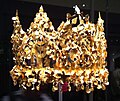







![Crown of the Andes, ca. 1660-1770, made for a larger than life-size statue of the Virgin Mary in the Cathedral of Popayán, Colombia. Now is at the Metropolitan Museum of Art[8]](https://upload.wikimedia.org/wikipedia/commons/thumb/d/d9/Crown_of_the_Virgin_of_the_Immaculate_Conception%2C_known_as_the_Crown_of_the_Andes_MET_DP365520.jpg/103px-Crown_of_the_Virgin_of_the_Immaculate_Conception%2C_known_as_the_Crown_of_the_Andes_MET_DP365520.jpg)









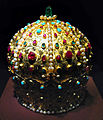
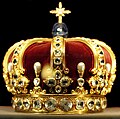
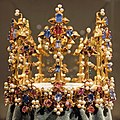


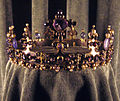












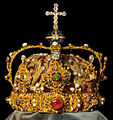
![Replica of the crown designed for the Finnish monarch, who never reigned. A contemporary crown was never crafted, but the replica was made from original drawings in the 1980s.[9]](https://upload.wikimedia.org/wikipedia/commons/thumb/d/dd/King_of_Finland%27s_crown2.jpg/112px-King_of_Finland%27s_crown2.jpg)


